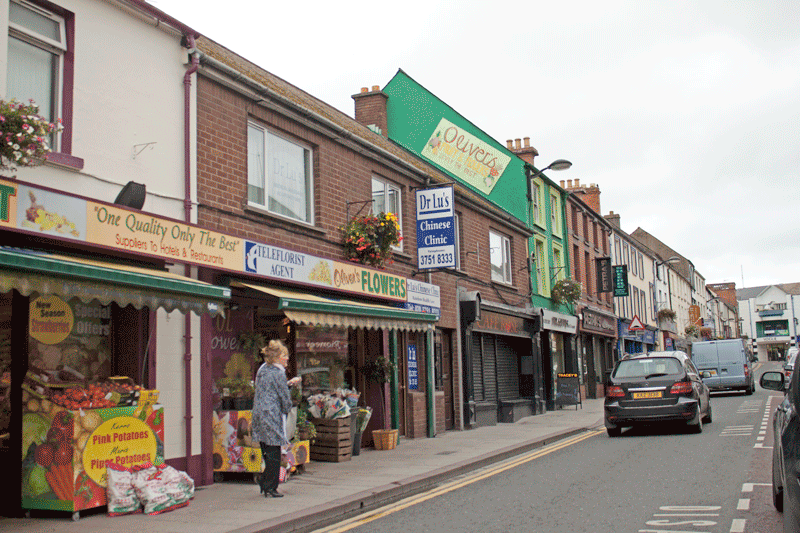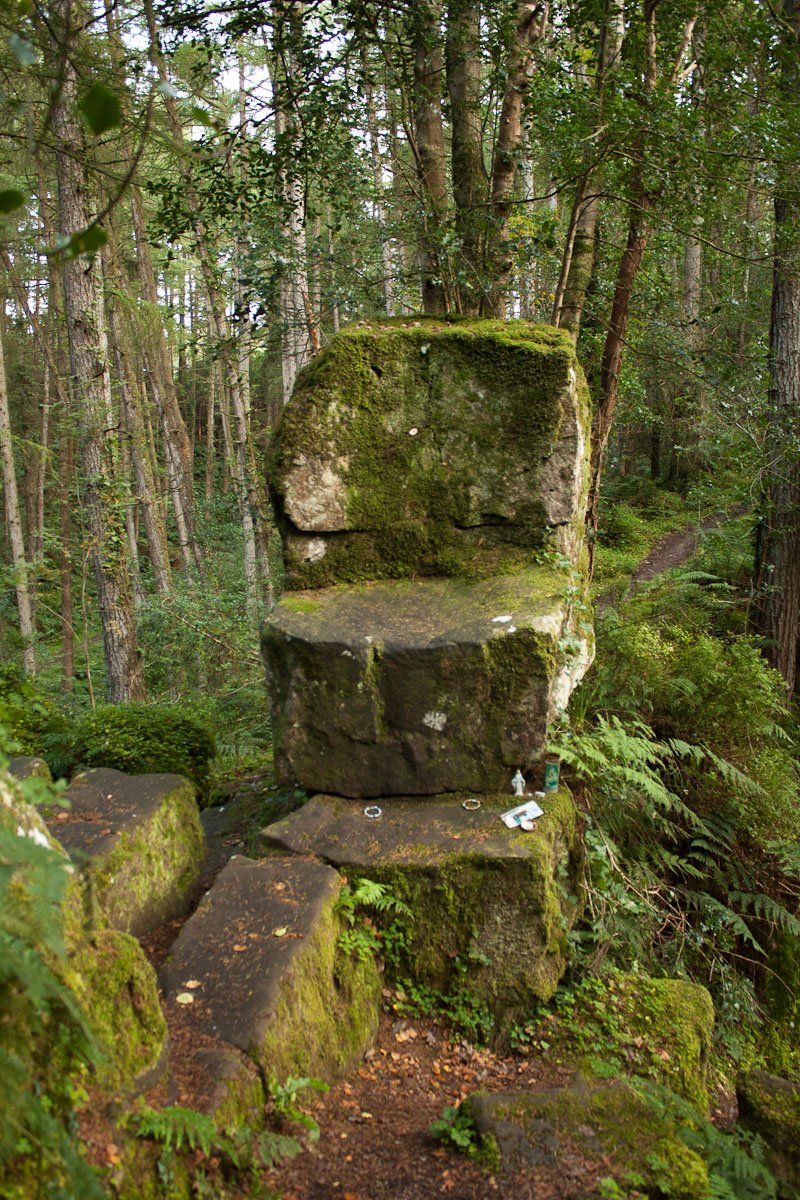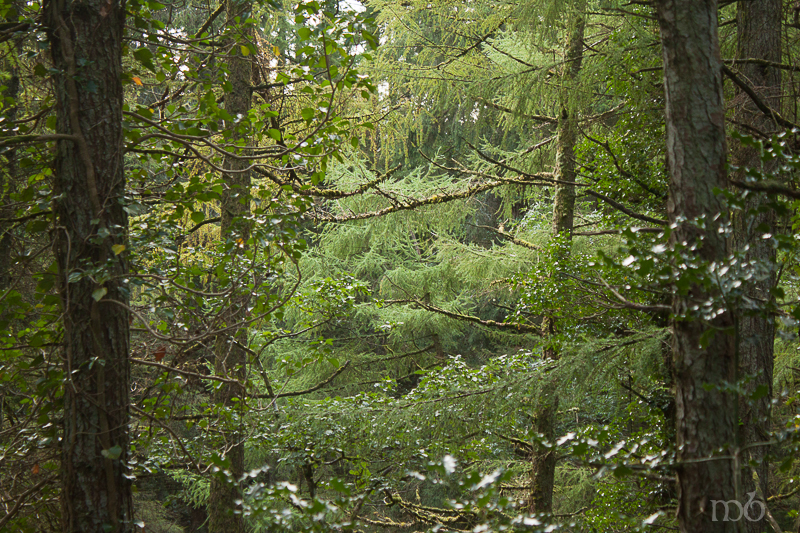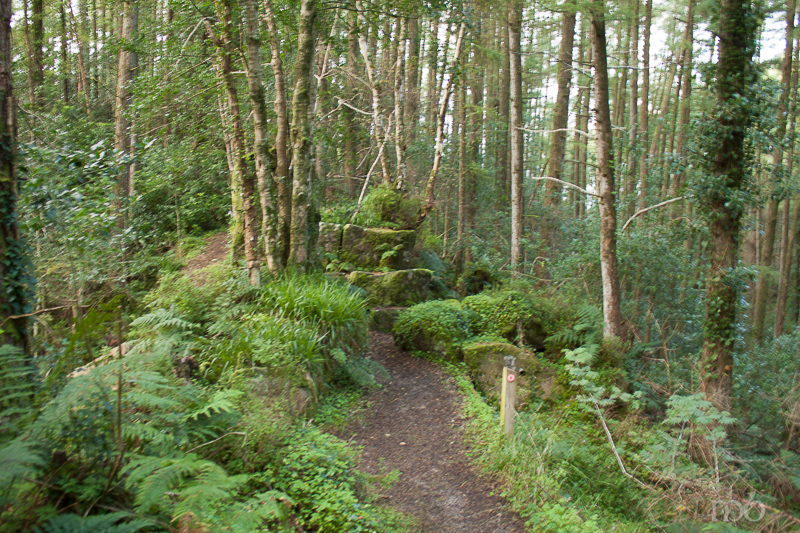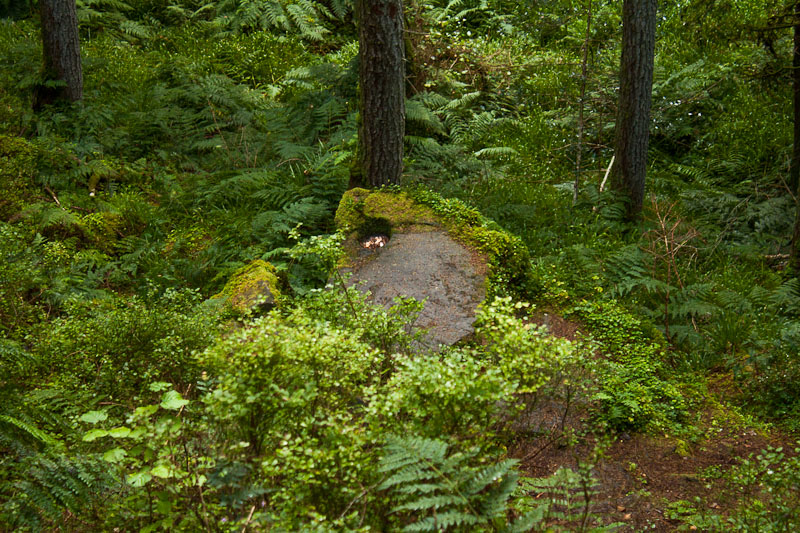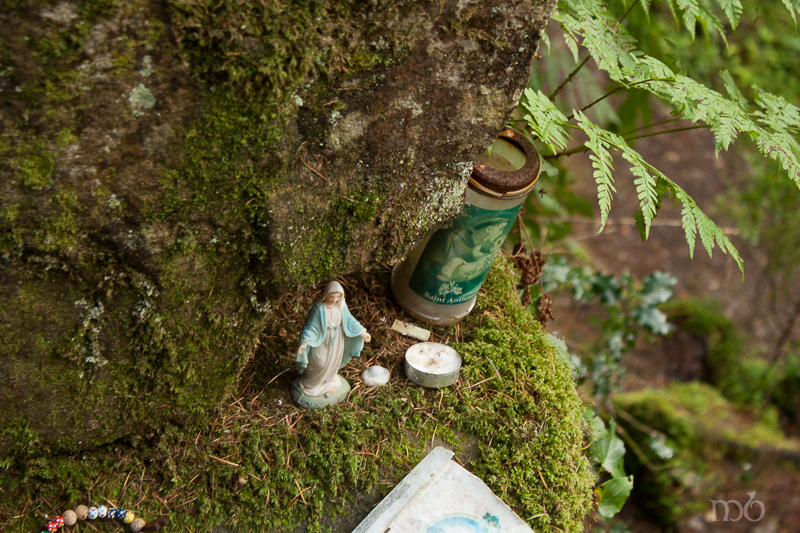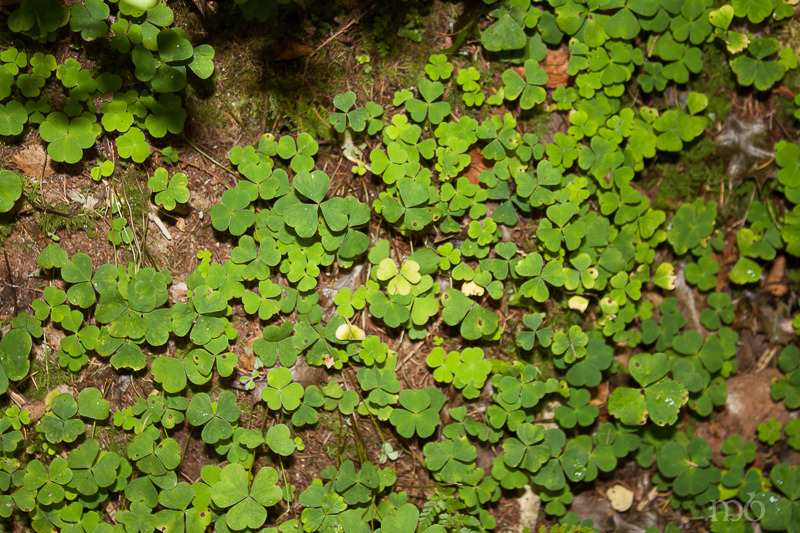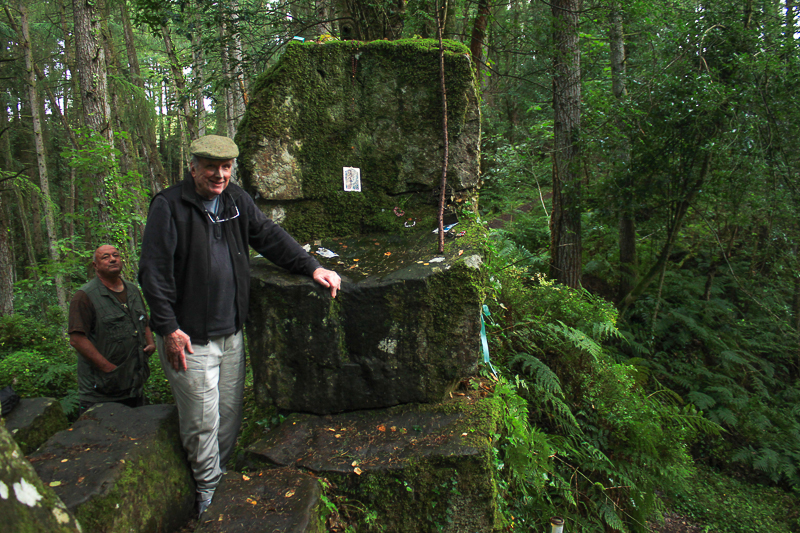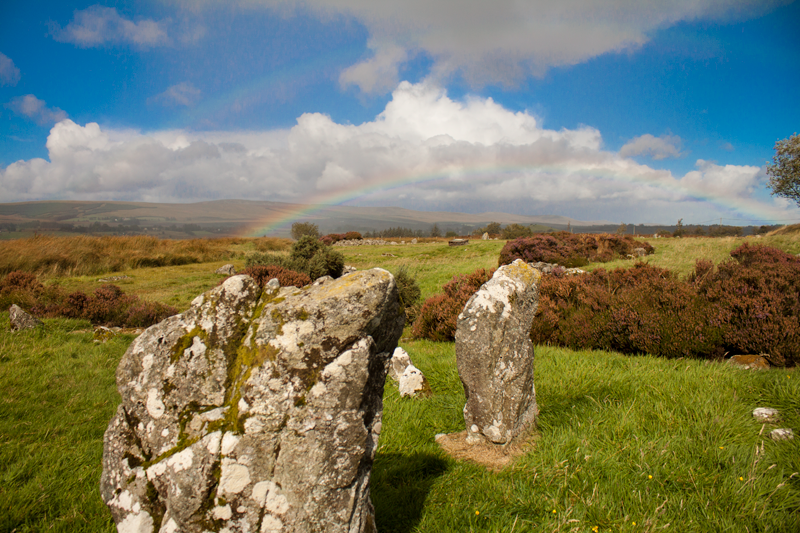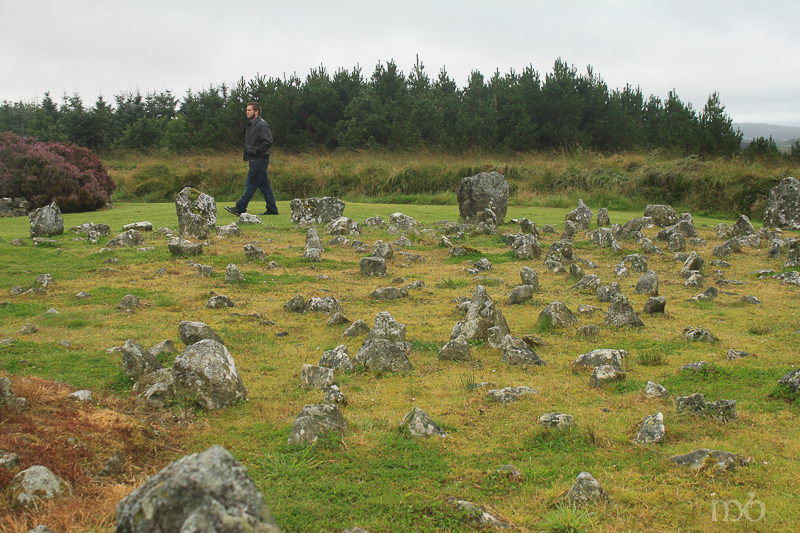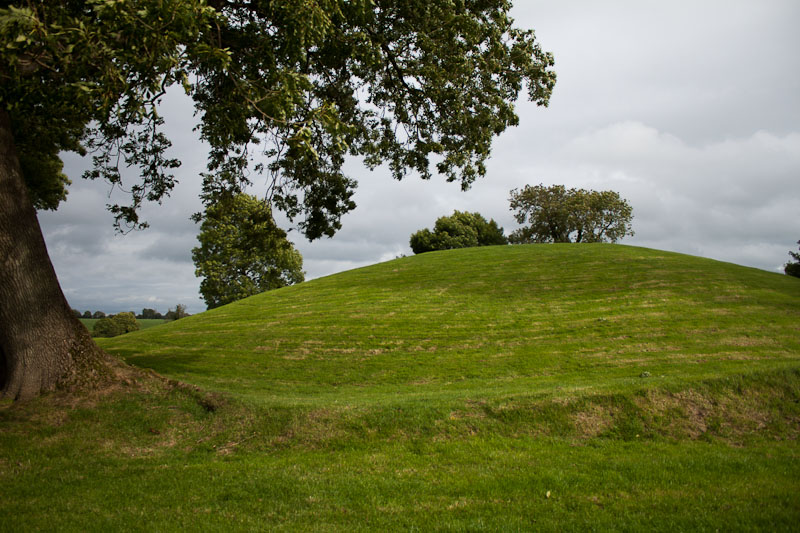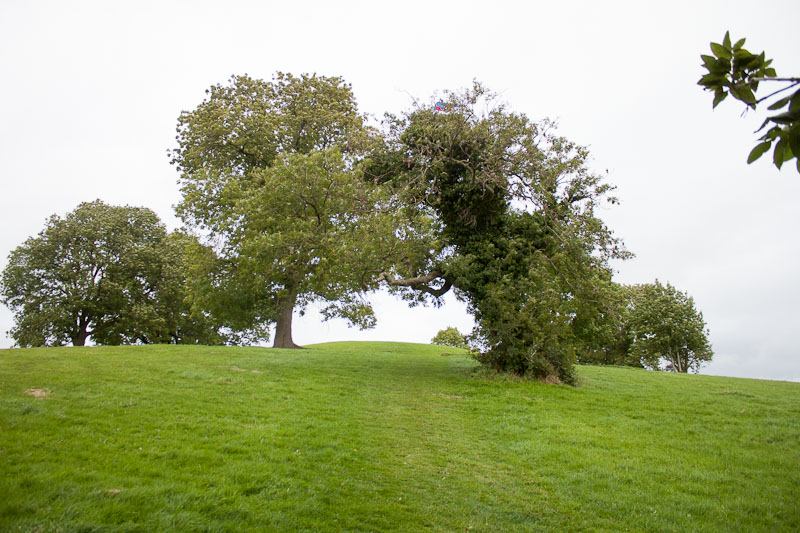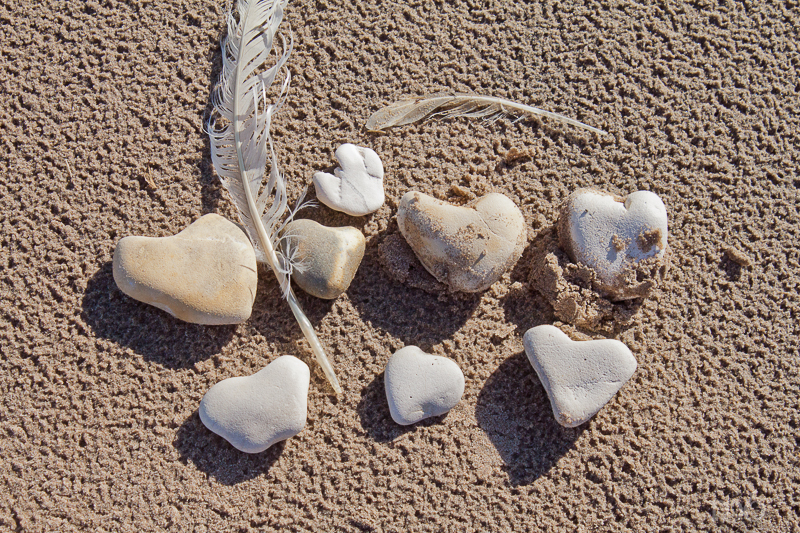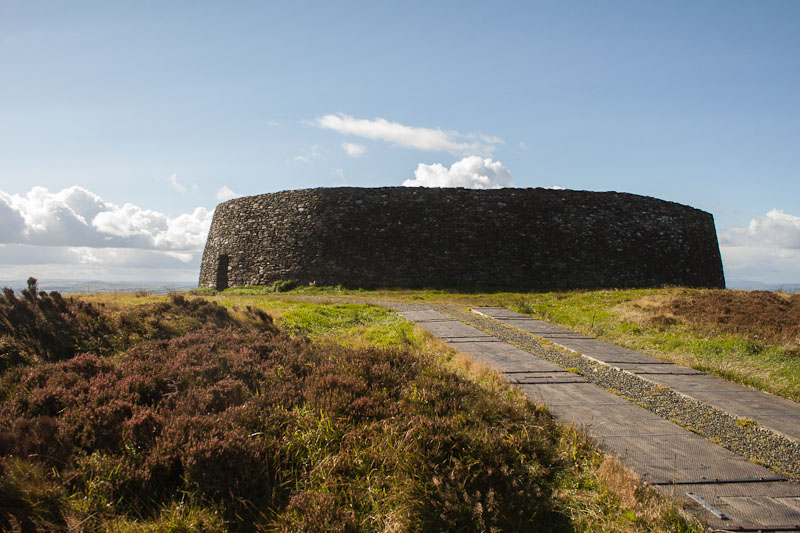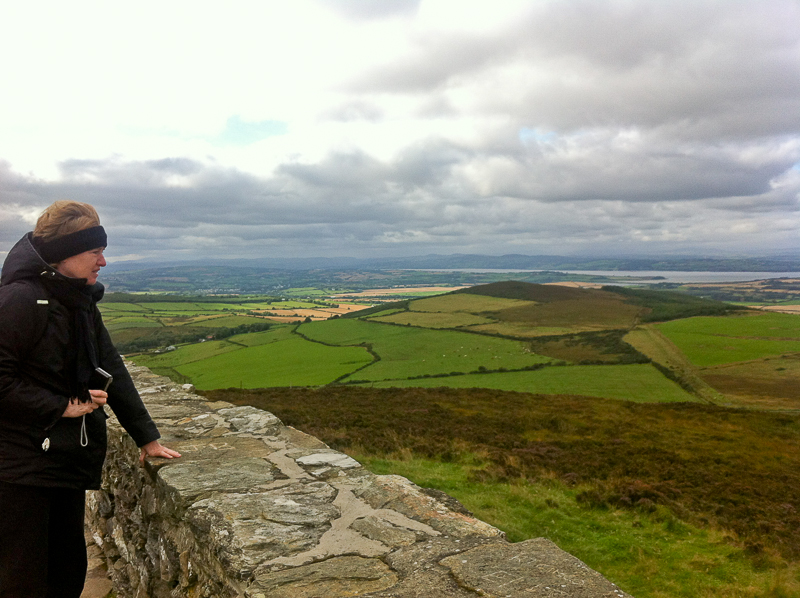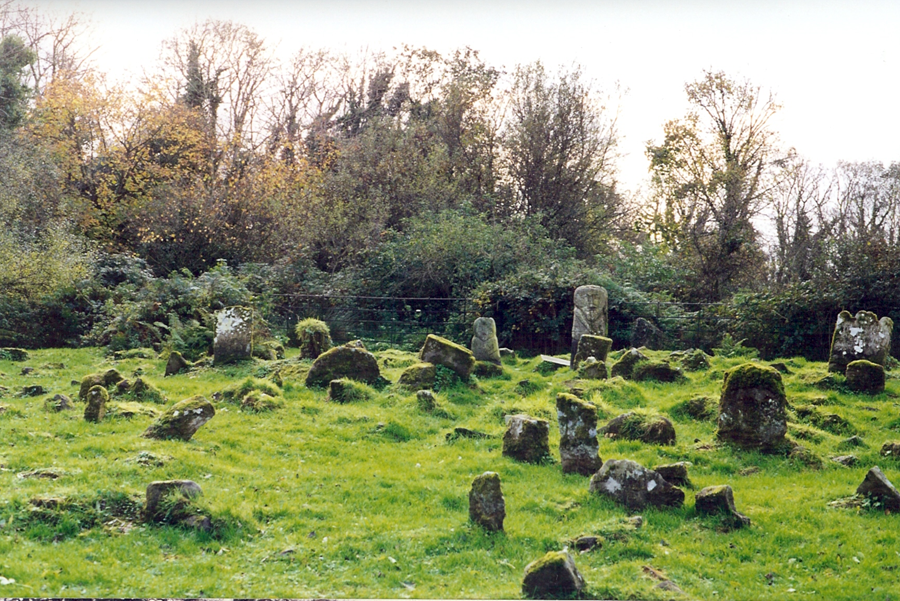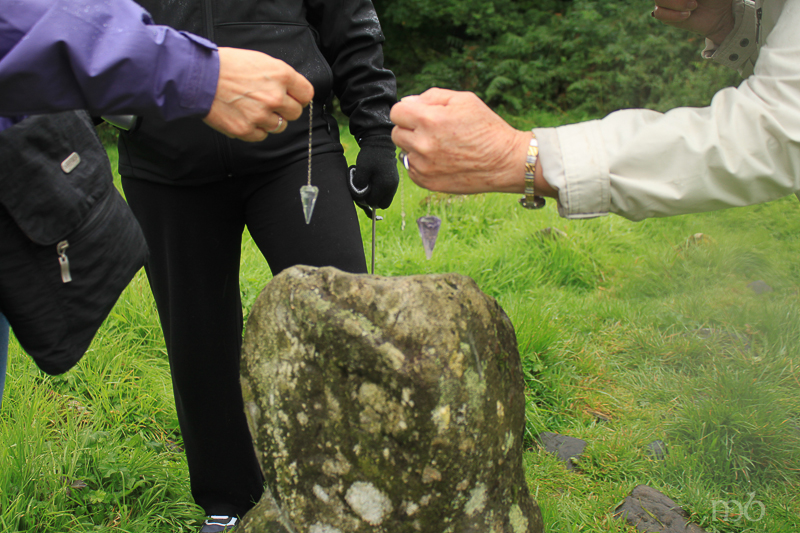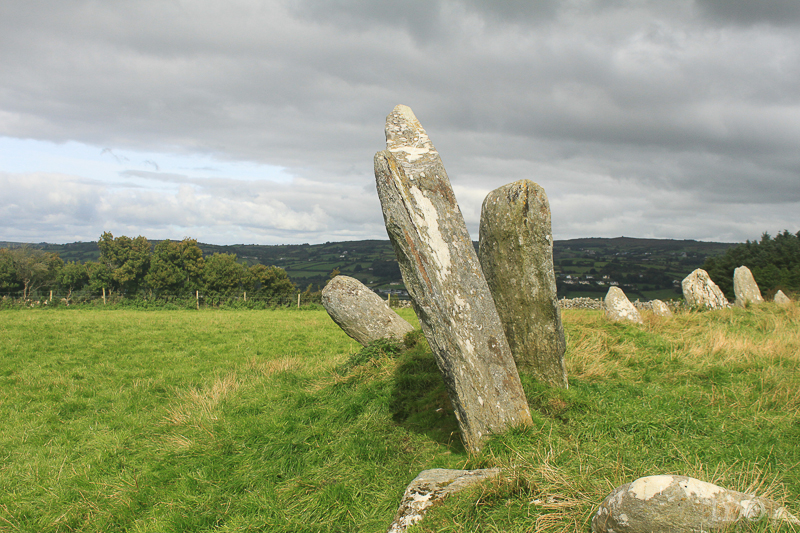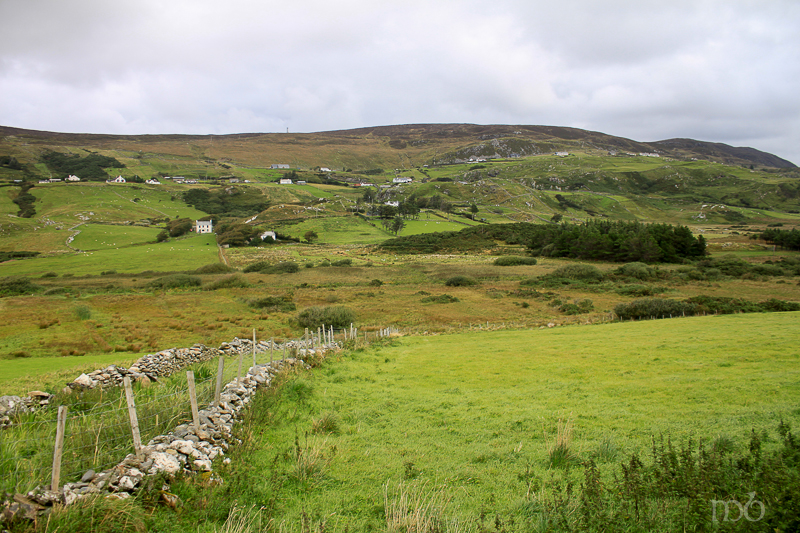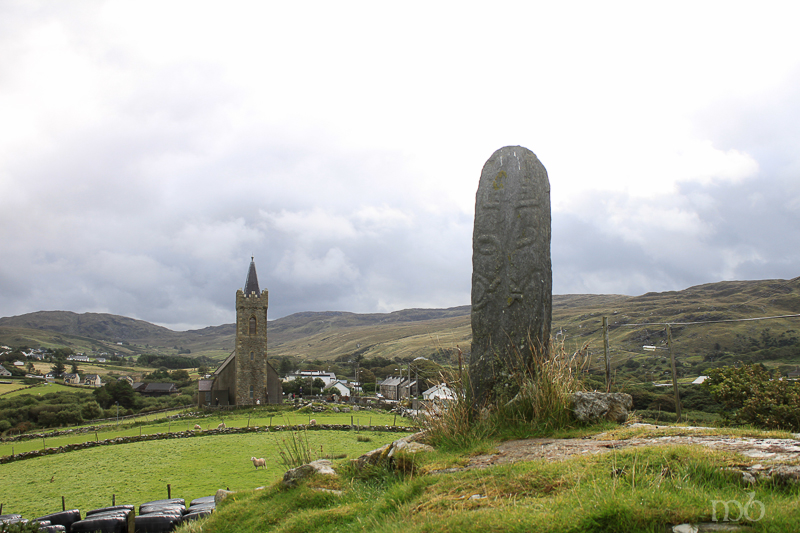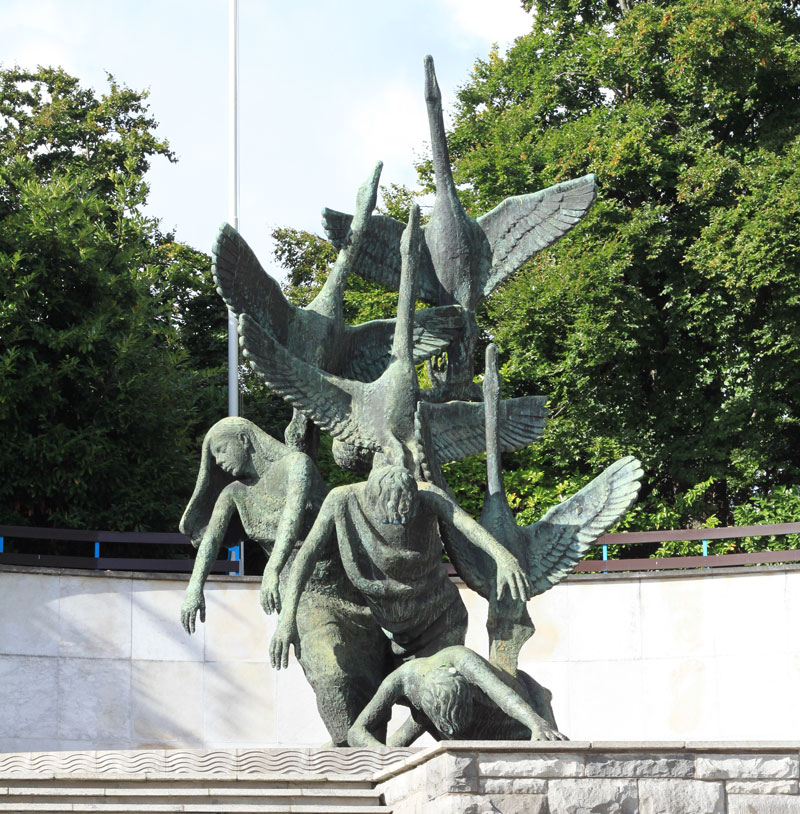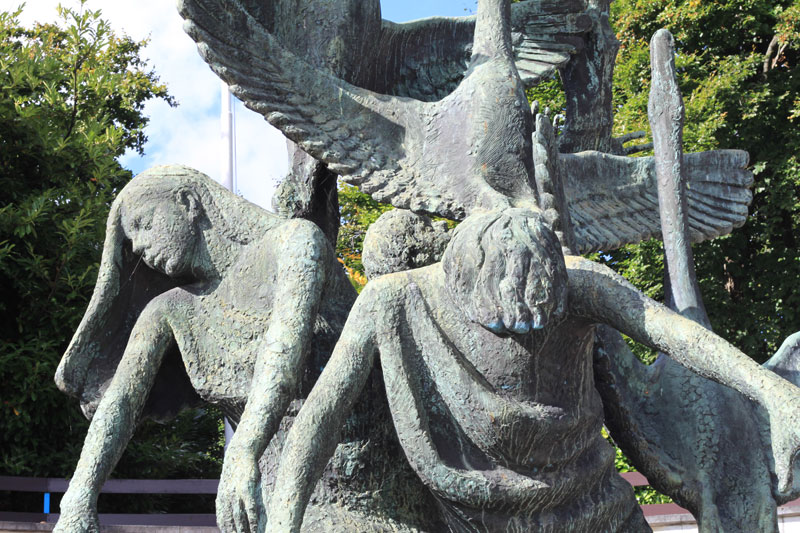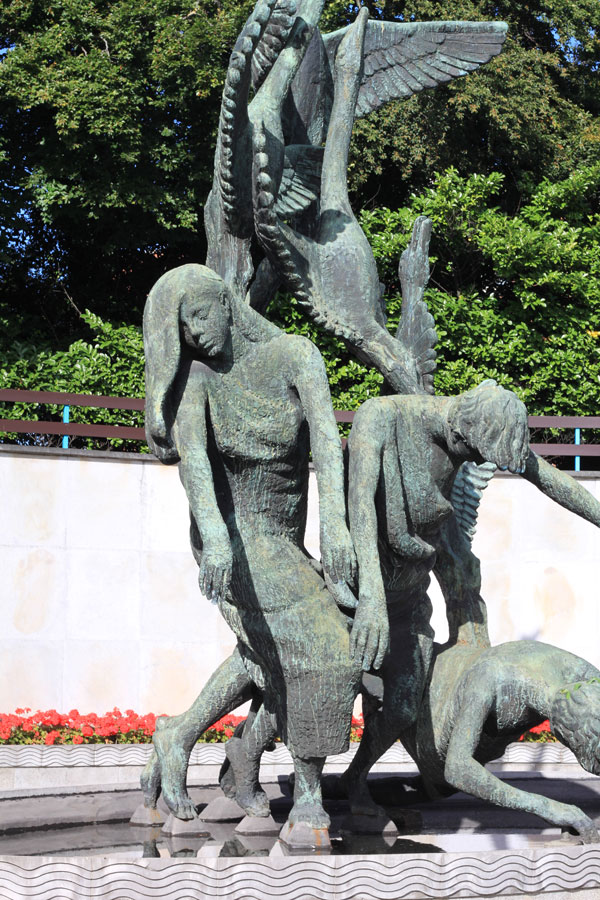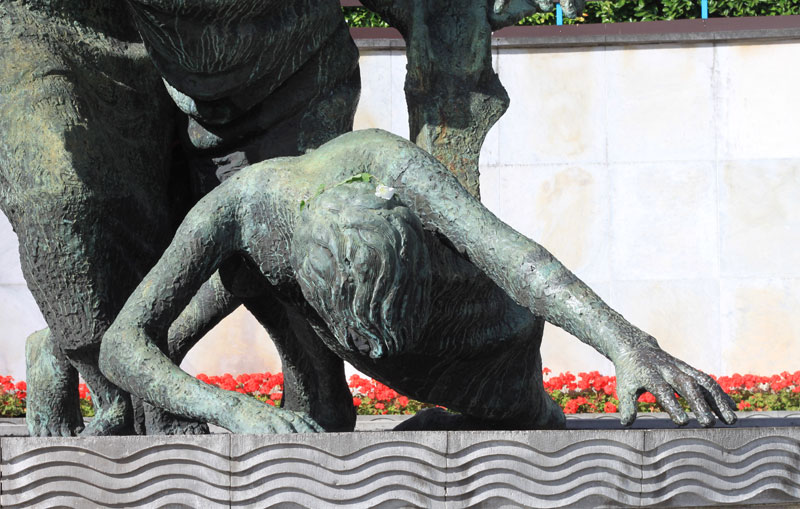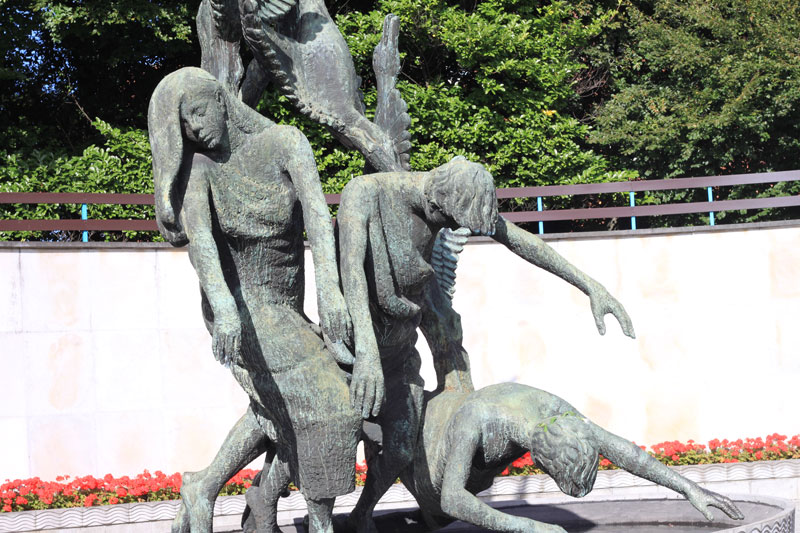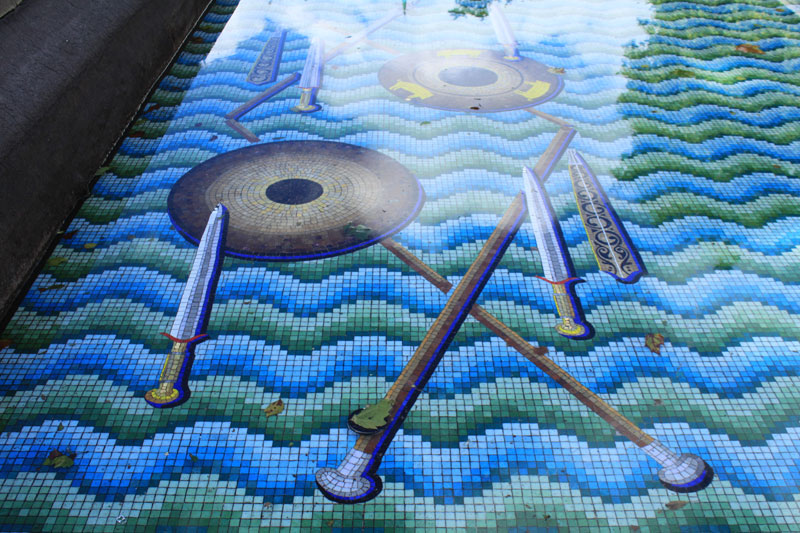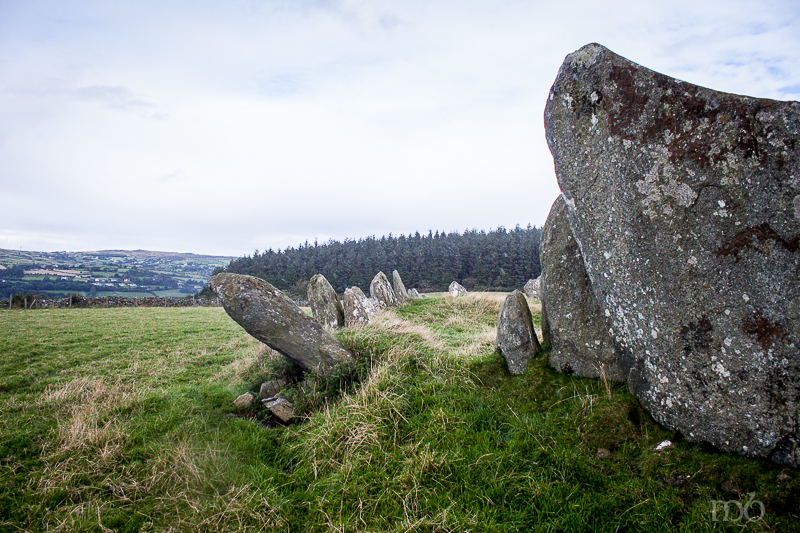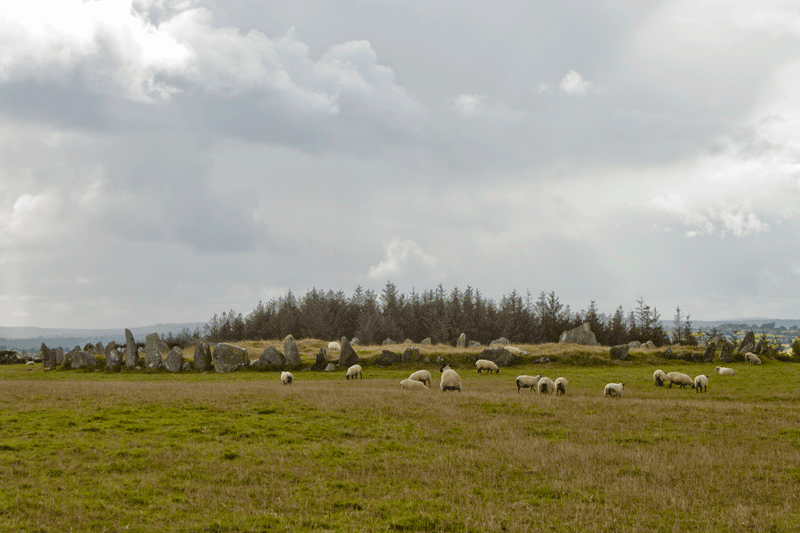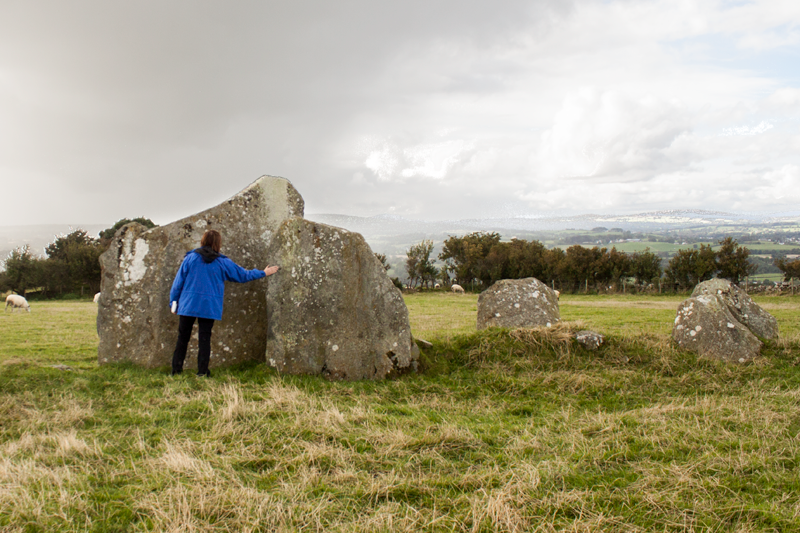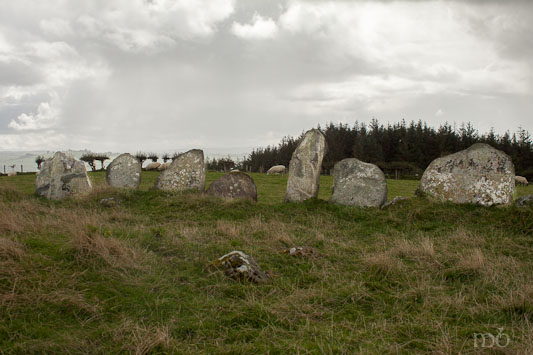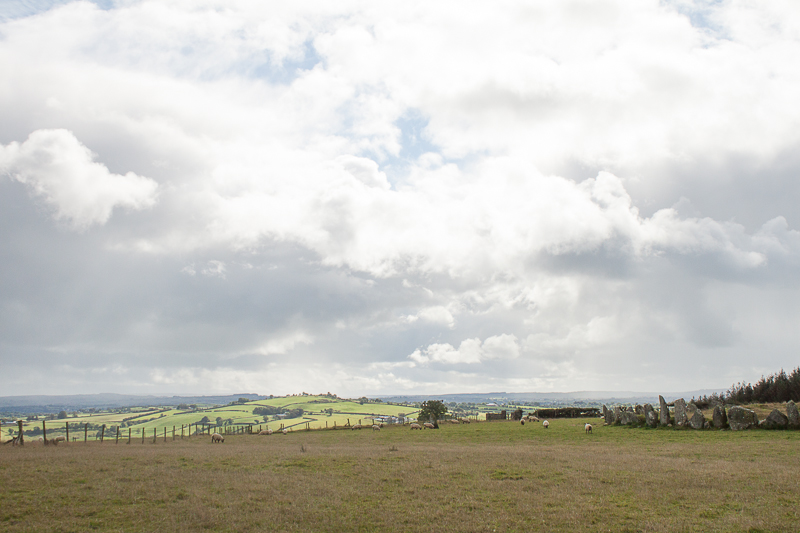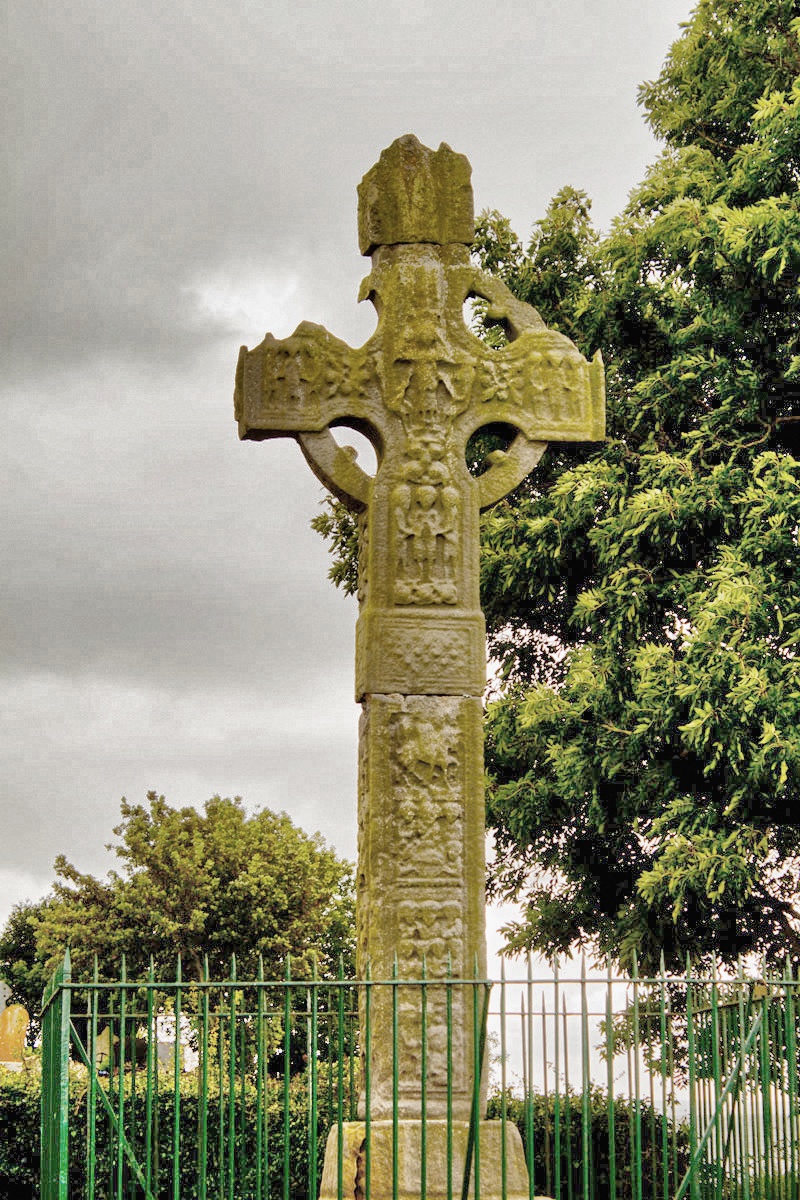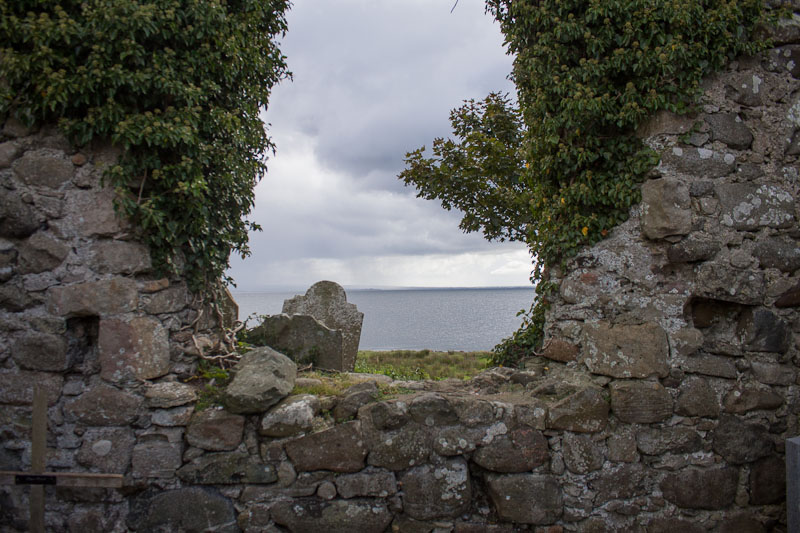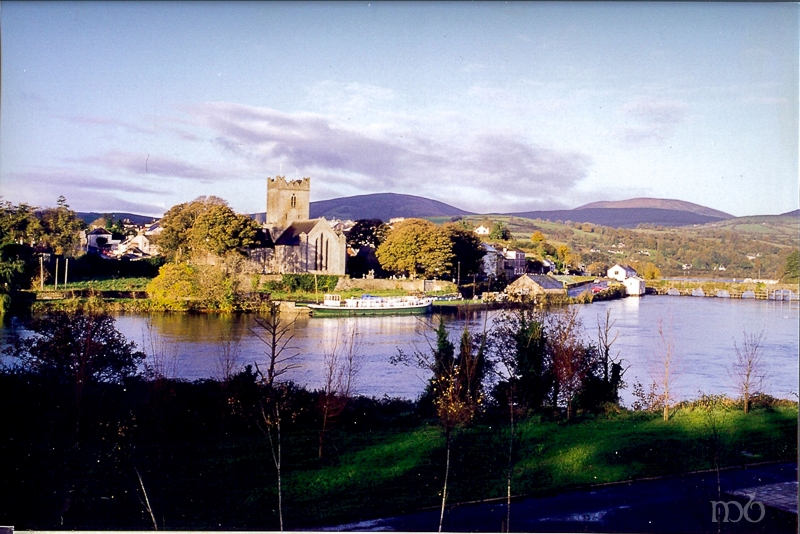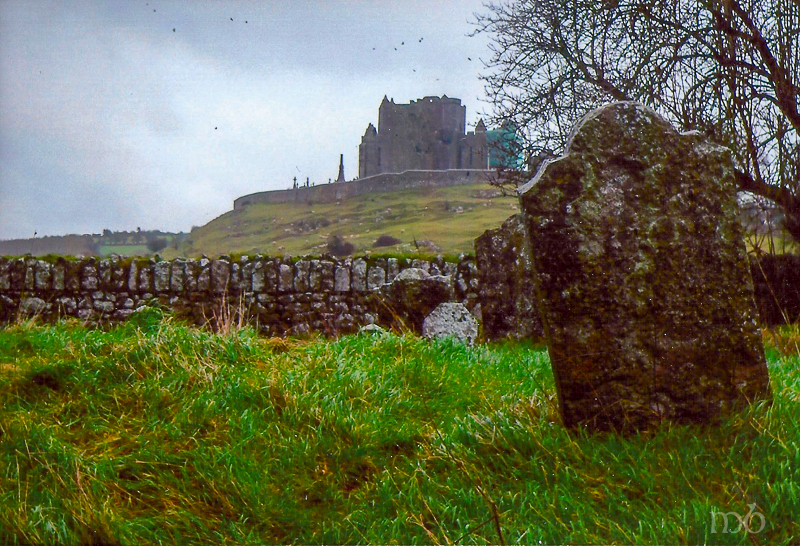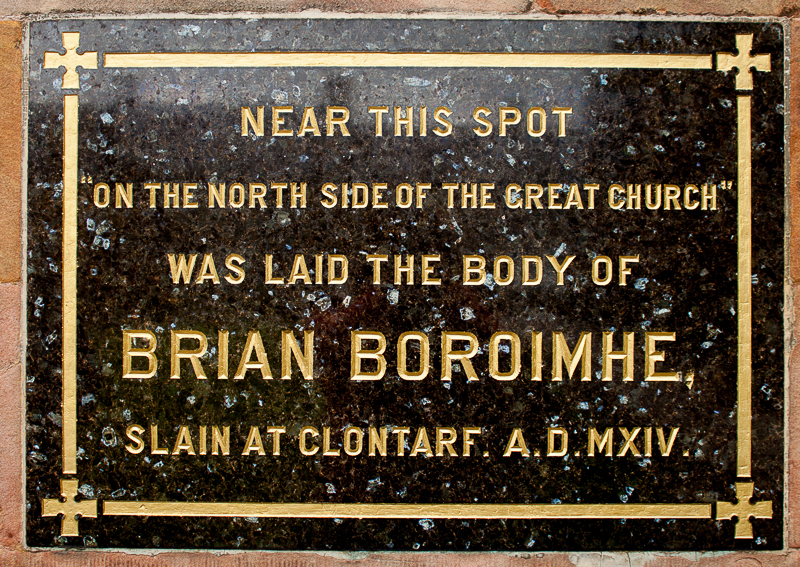St. Patrick’s and St. Patrick’s – Twins, Curses and Blessings in Armagh
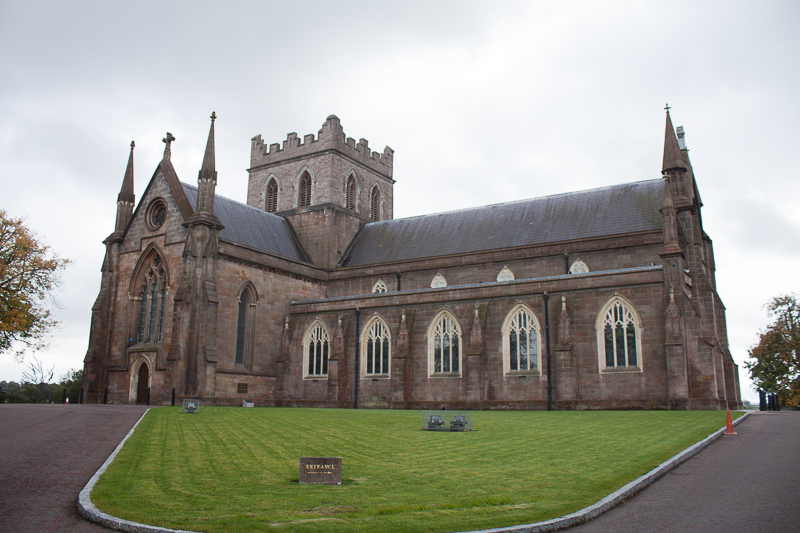 St. Patrick’s Cathedral in Armagh – Church of Ireland
St. Patrick’s Cathedral in Armagh – Church of Ireland
Coming into Armagh from the Monaghan Road one gets a dramatic view of the city skyline, especially at twilight. The view is dominated by two buildings on two hills – St. Patrick’s Cathedral and St. Patrick’s Cathedral.
Both are diocesan bishoprics, both are built on holy ground and both are tied to legends of St. Patrick. One is the Church of Ireland cathedral built on the ancient holy site where St. Patrick is believed to have built his first stone church in the 5th century. The other is a stunning Gothic-style Roman Catholic Cathedral, its cornerstone laid on St. Patrick’s Day 1840. It was completed in the early 20th century, with a serious halt to the construction during the Great Hunger. Armagh is known for being the ancient seat of the Ulster kings and the place that gave us the Knights of the Red Branch and Cuchulainn – the Hound of Ulster, a who was the Incredible Hulk of Ireland.
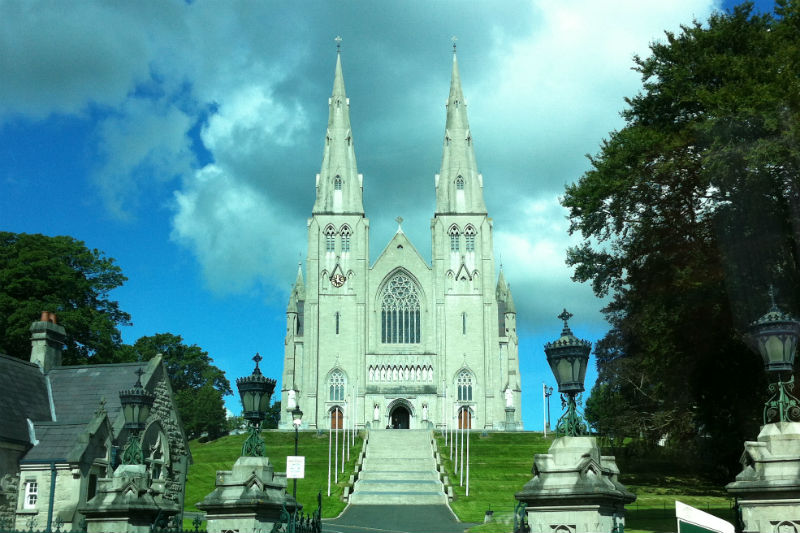 St. Patrick’s Cathedral in Armagh – Roman Catholic
St. Patrick’s Cathedral in Armagh – Roman Catholic
Armagh is also a city defined by twins linked to tragedy and triumph. Armagh comes from two Irish words that together mean the “Hill of Macha” or the “Height of Macha.”
Ard means hill or height and Macha is the name of an Ulster goddess who had super powers enabling her to run faster than any living creature. When she was pregnant and near delivery, her prideful husband boasted to the local king who was also prideful about his swift horses, that Macha could outrun them. The embarrassed king ordered Macha to prove it by racing his fastest horses in a competition staged in the presence of all of his friends.
Macha begged for mercy because she was heavily pregnant, but the king refused her pleas and forced her to run the race. Macha ran – and won. All, including the king were in awe of her strength. But at the end of the race Macha collapsed and died whilst giving birth to twins – a boy and a girl, one representing a blessing and the other a curse on the Ulstermen to last nine generations. The blessing was that Ulstermen would develop great strength and be the mightiest warriors in all the land. The curse was that at the times when they are in the greatest need, they would be stricken with the pains of childbirth and be incapacitated for five days and four nights. The boy went to sea (the otherworld) and met his mother and the other gods and goddesses. The girl stayed behind, motherless in a world that exploited and oppressed her kind.
Twin Cathedrals
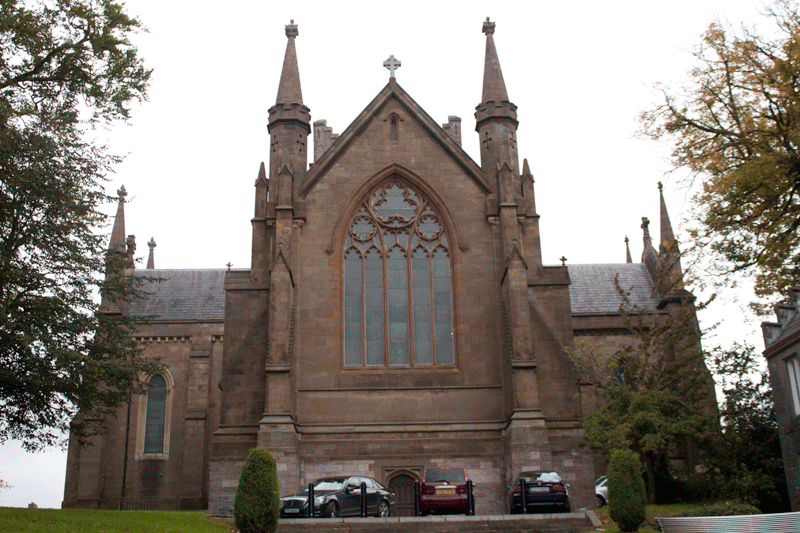 St. Patrick’s Cathedral (COI) in Armagh
St. Patrick’s Cathedral (COI) in Armagh
The twin pinnacles in the Armagh skyline are side-by-side hills each capped with a cathedral of two similar faiths. The two religions have a history of bloody conflict that goes back 700 years. They are the Catholics and the Protestants of Northern Ireland. Some say they mirror the ancient story of the twins of Macha, forced to be birthed violently because of pride, arrogance and greed. One allowed to be the warrior and the other oppressed with little power, forced into servitude. Triumph and tragedy. Blessing and curse.
But today’s Armagh shows few remnants of that conflict. People are warm and friendly, the downtown has nice shops and restaurants. It’s a busy town, but there are only scant traces of the brutal conflict that raged only a few decades. If I hadn’t been to Northern Ireland during the Troubles, I wouldn’t be able to measure the difference. But as a visiting American who traveled there both when the country was occupied and in recent years, I see the radical difference. Today there are no soldiers in the streets with machine guns, or crouching in alley ways, no razor wire, no moratorium on cameras and taking pictures, no tense people who don’t look up as you pass them on sidewalks – locals who provide no warm welcome for visitors… except for a few who were in the tourism business, and even they were guarded.
Armagh and the North – Good Times and Bad
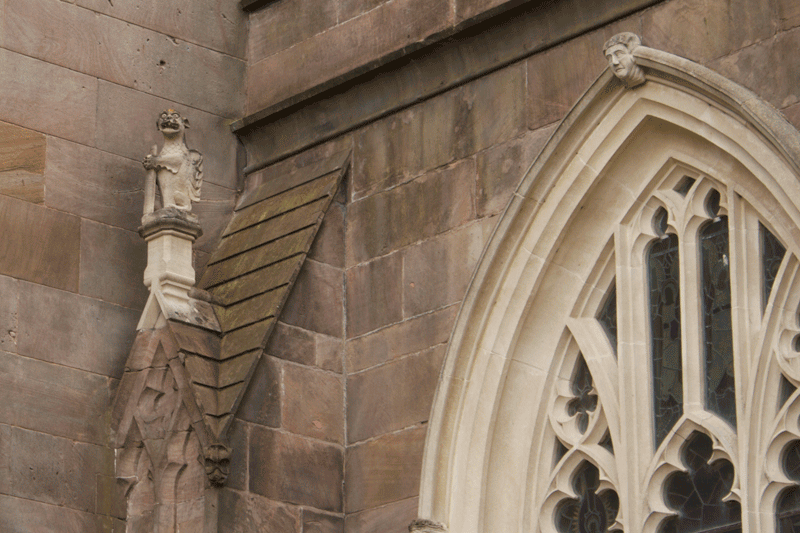 Gargoil on St. Patrick’s Cathedral in Armagh
Gargoil on St. Patrick’s Cathedral in Armagh
Don’t get me wrong. I loved Armagh then and I love it now as I love all of Northern Ireland. The only difference between the two time periods is that the curse is lifted. The two sides want to get along. They want peace. They want their children to be safe. They want to thrive economically and welcome visitors. Both sides know and always have known that they live in a magical land – a land of pristine beauty, a land of stories, a land of mystical energy. They’re eager to share their country’s treasures in the safe environment that has grown out of their commitment to peace. And visitors are very welcome.
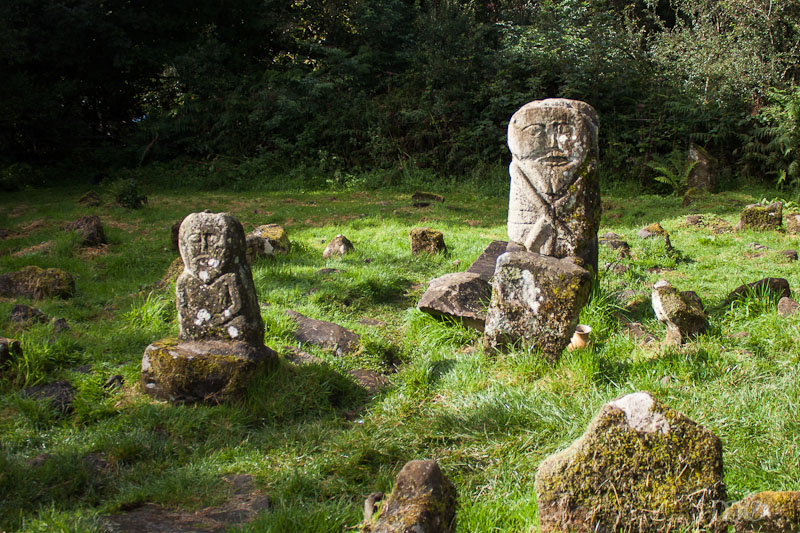 Janus figure – Caldragh Cemetery
Janus figure – Caldragh Cemetery
During all of the troubles and conflict, the ancient Janus figure still stood watch in that mystical cemetery named Caldragh in County Fermanagh. Saint Patrick’s Chair and holy well was still perched in the Altadaven Forest waiting for pilgrims to come forward and present their wishes. The sands of Whitepark Bay still sang in the wind. The stone circles at Beaghmore were still lying in wait in the shadow of the Sperrin Mountains ready to enchant the visitor looking for those spiritual ports in the storm that we call thin places. The North has always been beautiful and worth visiting, but it’s good to see the people of the North enjoying their land and each other.
Discover the North Tour
Both St. Patrick’s Cathedrals in Armagh are a part of our Discover the North tours as are St. Patrick’s Chair, Caldragh Cemetery, Beaghmore Stone Circles, Whitepark Bay and many other mystical sites.
Related Posts –
Padua House and Kathleen O’Hagan of Armagh
Armagh – Twin Symbols of Conflict and Unity
St. Patrick’s Chair – Make A Wish
The old County Tyrone legend states that if you sit in St. Patrick’s Chair located in the Altadaven Wood, and make a wish – that wish will come true within one year.
Mine did. But I’m not telling .. because you’re not supposed to tell. You’re supposed to keep it all to yourself.
This throne-like chair is carved out of one huge hunk of rock, and how it got placed so high on a cliff-like edge of the path through the woods is anyone’s guess. It’s been there for centuries.
Altadaven means “cliff of the demons.” It’s believed that this site, found deep in the thick forest surrounded by amazingly tall fir trees and hard woods with holly and ivy and fern lining the path, was once a meeting place for the druids. The legend tells of how St. Patrick came to this place and drove the demons (druids) “over the cliff.”
So what once was pagan became Christian. And what once was a center for druidic ritual became a center for prayer and Christian devotion. Today, tokens left behind at the site suggest both Christian and non-Christian people come as pilgrims to this powerful site.
There is a definite separation of energy at the entrance to Favour Royal Forest – as it used to be known. The entrance to the forest is a defined edge, with a keen sense of power. It’s a crossing, an opening into place with different energy.
The forest is thick and damp and the trees tall and slim with feathery leaves. The path is lined with ivy and fern. It is part of an old road called the Sliabh Beagh Way that runs across the countryside. It’s long been known as and enchanted road, and the forest around this part of the path is still referred to as the Fairy Green. It ascends to Pinnacle Rock which is where the Chair is.
I knew that we were on our way to see St. Patrick’s Chair because a friend brought me there. But I wonder how travelers would feel who didn’t know it was there – they were just walking this ancient path feeling the closeness of the trees and the energy around them… and then …. at the top of a rise they see this throne-like chair, six feet high, hewn from a boulder. And suddenly they know this is some special place. Some amazing place of resurrection.
From the chair there is a steep path leading down to another massive rock, this one with a small well carved out. There is water in the well and the path is lined with clooties and rags left behind by people who brought burdens to this holy well. They say the well never runs dry and that the water has healing properties. Others say the rock with the bullaun is covering an open chamber.
Tokens have been placed on the chair by pilgrims. Rosaries, holy cards, medals, statues, coins, a candle. The air is thick with wishes and dreams both recent and ancient. So many hopes are left to rest on St. Patrick’s Chair.
If you visit St. Patrick’s Chair, be sure to make your own wish. But don’t tell anyone.
The air around this place is charged with an energy that is no so gentle but more powerful, thick with presence. And the beauty of the forest is stunning. So much of Ireland is rock and open fields and rolling hills. A forest that one can easily walk through is a special to find.
If ever there was a portal into the world beyond this on, it would be here.
St. Patrick’s Chair and Holy Well are on the 2014 Discover the North Tour of Ireland.
Kildare – St. Brigid’s Holy Well (Tobar Bride)
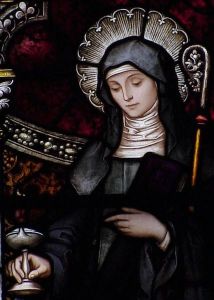 Legend tells us that St Brigid was born near Kildare to a slave mother who was a Christian and very sickly. As a child, Brigid persuaded the Druid master to free her mother which in turn freed Brigid to enter religious life.
Legend tells us that St Brigid was born near Kildare to a slave mother who was a Christian and very sickly. As a child, Brigid persuaded the Druid master to free her mother which in turn freed Brigid to enter religious life.
Kildare is one of the stops on the Thin Places Mystical Tour of Ireland – Castles, Saints & Druids in September 2014.
Since there were no convents in Ireland, Brigid began one in Kildare. The sisters of St. Brigid prayed simply and deeply and served the poor. We know that Brigid was a contemporary of St. Patrick and a strong legend states that she was ordained a bishop because of her superior knowledge and closeness to God.
Another legend is associated with the goddess or holy woman, called Brigid dating back to pre-Christian times in this region. Stories of the two women have been woven and spun into legends and tales that all point to a holy woman, who drew followers to this site and performed rituals that were associated with healing, protection, comfort and help for the poor. The town of Kildare grew up around the community that this woman – Brigid – founded.
Kildare translated means “cell” or church of the oak. Oaks were known to be sacred trees in pre-Christian Ireland which gives weight to the pagan or goddess tradition of Brigid. But it is believed that a Christian woman named Brigid founded a community here around 480 AD, that she was a contemporary of St. Patrick and was recognized for great spiritual wisdom. There are legends that she was ordained a bishop in the church due to her wisdom.
Brigid is now one of Ireland’s patron saints, and is often linked in patronage to farmers and poor pastoral workers – the common citizen, the oppressed Irish tenant farmer of past centuries. It is possible – some say likely – that St. Brigid located her religious community on the spot where the Kildare Cathedral is now situated. 13th century buildings now occupy the spot along with the second tallest round tower in Ireland and an oratory and fire pit which likely date back to pagan times. Legend states that St. Brigid kept an flame burning in the fire pit continually as a devotion to the Holy Spirit. The perpetual flame is still cared for today by the Brigidine sisters who live nearby. For centuries this cathedral site has been a draw for pilgrims – a holy place, a place of spiritual strength.

Nearby is St. Brigid’s Holy Well, and the thinness of this place is palpable. This is actually a secondary well, springing from a known ancient holy well a short distance away. Volunteers and benefactors have created a beautiful setting around St. Brigid’s Holy Well also known as Tobar Bride. A bronze statue of St. Brigid lifting the eternal flame has been added in recent years. Stone prayer stations lead from the well to a running spring.
Wells were considered holy by the pre-Christian Irish being that they sprung from the “underworld” or the womb of the earth. That tradition of holiness exists today. Water from holy wells is believed to have special power for healing and spiritual protection.
“A holy well is very special. To watch water springing from the earth is to witness creation in the act of pure, unconditional generosity. At a holy well, my own interior holy well has an opportunity to make itself known to me.” – Gay Barbizon, Brigid’s Kildare; The Fire, the Well and the Oak.
Upon entering Tobar Bride, the pilgrim can see a small devotional shrine where donations are publicly accepted and welcomed. The old pagan tradition encourages the pilgrim to leave an offering when taking water from the well.
Pilgrims are encouraged to say prayers at each of the seven stations at Tobar Bride. Just past the small devotional shrine is the spring marked by a stone arch. This is the first station. Water flows through two oval shaped stones. Some say these stones symbolize the breasts of the earth – our mother. The bronze statue of St. Brigid is near to the arch.
Past the arch are five standing stones or “stations” that represent a part of Brigid’s nature. Pilgrims pause and recognize these qualities and perhaps pray for the same graces to develop in their own lives.
First stone – Brigid the woman of Ireland, the patroness, the protector of a beloved country.
Second stone – Brigid the peacemaker, healing division, bringing forward unity.
Third stone – Brigid the friend of the poor, advocate of the marginalized, speaker for they that have no voice.
Fourth stone – Brigid the hearthwoman, keeping the home flame burning, welcoming all, woman of hospitality.
Fifth stone – Brigid the woman of contemplation, which leads to wisdom and closeness with the Creator.

St. Brigid’s Holy Well – Kildare
The holy well behind the five standing stones marks the 7th station. It is here that one can pause and reflect, pray for a loved one, and draw water – perhaps to take to a loved one who is ill or to bless a home.
It is traditional belief that a person taking something from (holy water) from a devotional site should leave something behind. Notice the tree behind the well. Dangling from its branches are stips of cloth and other tokens – also known as “clooties” – that have been left behind by pilgrims. The cloth may have been touched to the person for whom the pilgrim is praying. Sometimes pilgrims leave photos or personal belongings behind – things that have touched the person they are praying for. This tree had a baby’s shoe dangling from a branch.
The pastoral setting of this park-like devotional space is near the Curragh – or places where the thoroughbred race horses – famous in Kildare – run and are kept. It is almost impossible not to be moved when entering this space.
This is a very Thin Place.
7 Sites in Northern Ireland that Feed the Soul
I remember visiting Northern Ireland in the days when the military occupied the border equipped with machine guns and combat gear. I loved the north just as much then as I do now that the army, barbed wire and weapons are gone and a quiet peace has settled over the land. It’s a rugged, raw and ancient landscape that isn’t changed by external forces. Battles come and battle go, but the land and its sacred places remain unmoved and unchanged.
The North is my favorite region probably because the bones of the old landscape still peek through the sod without having to fight massive motorways and residential developments for attention. The ancients knew the energy was powerful here, and they marked many of their sacred places. While some markings have fallen away, the energy still lives. It continues to nourish the human spirit today just as it has for thousands of years.
Sadly, most tourists in the north pass by these special places not realizing that just off the road they’re driving on are stopping places where the traveler can walk in two worlds at once. Here are seven of my favorites in the North. You can’t approach this thin places and not be moved.
BEAGHMORE STONE CIRCLES – Co. Tyrone
I’m an earth energy novice. Like most common people, I can tell when a place has a sacred feel, but I can’t feel the energy move through the stones and emanate from earth the way some of my friends can. But Beaghmore radiates energy that even I can feel. It’s palpable.
Beaghmore is a series of seven stone circles set in a clearing at the edge of the Sperrin Mountains in County Tyrone. Six of of the circles are paired and one stands alone. The circles date back to 2000 BC. Artifacts excavated from the site suggest ritual activity 1000 years before that.
Two interesting things about Beaghmore – The circle that stands alone has 800 jagged stones set in the center (known as Dragon’s Teeth) and one circle has a portal to the Otherworld. In the center of the circle with the portal is a recent burn mark in the center of scorched grass and earth. It is currently being used as a ritual site.
Read more about the mystical nature of Beaghmore on Maura Brooks’ blog.
THE GIANT’S RING – Belfast
Belfast gets a ton of visitors. But how many know that just outside the city is henge monument that predates the pyramids of Egypt? A henge monument is a circular enclosure with a ditch carved out inside the ring. A henge fort is the same circular enclosure on the ditch is on the outside making it easier to defend the fort.
The Giant’s ring is a henge monument with the ring and ditch easily identified. The earth ring is about 600 feet in diameter and in the center is a slight hill crowned by a five large stones that support a large capstone. It’s believed that these stones on the hill are what remains of a neolithic passage tomb. The area is now preserved and used as a park. The visitor can do a ritual walk around the ring and then examine the stones in the center. There is actually a 3 mile defined walk of the ring and surrounds that includes a bridge that dates back to the Stone Age and a historic woodland.
There is a lovely energy here.
NAVAN FORT – Co. Armagh
I knew about Navan Fort being the legendary stronghold for the Knights of the Red Branch and the place where the goddess Macha died giving birth to her twins. Also known as “Eamhain Mhacha” or the “twins of Macha,” Navan Fort was associated with pagan ritual for years.
But what I didn’t know was that the famous mound (130 feet in diameter and about 20 feet high) had a fire ritual history. About 94 BC a wood temple supported by large oak pillars was built where the mound is and burned on the site in ritual fashion. The ruins of the temple were covered up with stone and earth creating the mound we see today. Excavation showed that soil used in the covering of the temple came from other places – some quite distant. Today people return to soak in the energy of the mound which apparently is still quite active. There is also a tradition of rolling down the mound to in order to soak in the energy of the mound whilst giving one’s own energy back to the mound.
At the base of the mound is a fairy tree, an old oak that looks much like a dragon rearing up against an enemy.
The story of Navan Fort is well told during the guided tour. For the full experience, pay the money at the Visitor’s Center and take the tour. The guides are fabulous and there is much to learn from them.
WHITEPARK BAY – Co. Antrim
Everyone knows about the great tourist sites on the Antrim Coast – the Giant’s Causeway, Dunluce Castle, Carrick-a-Rede Rope Bridge and the Bushmills Distillery. Travelers visiting these places pass right by Whitepark Bay not realizing what a mystical site they’re overlooking.
Right between the Causeway and Rope Bridge, just off the A2 is Whitepark Bay. It has a car park and solid stairway that descends to the magical beach where the sand sings.
True.
The sand on the beach is mixed with chalk from the cliff face which gives it such a fine consistency that when the wind blows a certain way (which it inevitably will) one can hear the sand “hum” with vibration. The cliffs are gorgeous and tucked into their vegetation overgrowth are the remains of passage tombs. This space in the landscape was considered sacred to the ancients. This beach is a thin place. It’s a portal, a threshold to the Otherworld. A place for thinking, for connection with your higher self. One only has to walk it to know this truth.
I collect heart shaped rocks when I travel as souvenirs from my twin granddaughters. This usually takes an hour or more to find the perfect rock shaped like a heart. At Whitepark I set out looking for two heart shaped rocks and asked my friend Maura to help thinking we could save time. Suddenly they were everywhere. Within 10 minutes we found 8.
8 … a mystical number for sure. The number that symbolizes infinity, connection to the Creator, the Cosmic Christ, the totality of the Universe. Maura kept one for herself. I brought 7 home. On sits on my desk. A daily reminder of Whitepark Bay.
GRIANÁN of AILEACH and the INISHOWEN PENINSULA – Co. Donegal
Driving the circle around the Inishowen Peninsula is at least a half-day, if not whole day commitment. But why not commit? It is some of the most spectacular driving in all of Ireland. And unlike many of the other spectacular drives (Ring of Kerry, Sally Gap, Connemara Hills, Molls Gap) it isn’t so crowded with visitors and coaches. Even in the cold and the pouring rain, the Inishowen is gorgeous. At its base on the south eastern side is Grianán of Aileach, also known as the Sun Palace.
Grianán of Aileach was the ancient royal site for northern Ui Néil from the 5th to the 12th century. The now restored cashel dates to the 3rd century and caps three concentric earth rings. The panoramic views from the cashel of the peninsula, Loughs Foil and Swilly and the city of Derry are dizzying – especially if you’re balancing yourself on the top ridge of the cashel.
There is also a tradition that the temple was built by Daghdha, the good god or god of the earth. He was known as the King of the Tuatha dé Danann, a race of supernatural beings descended from the Goddess Danu. They inhabited Ireland before the Celts. This tradition has Daghda building the fort to protect the grave of his son. A variation tells of giants building the hill and the Grianán on top a residence for the shining ones who gave birth to the children of the sídhe. All of these traditions link the hill and the fort on top with supernatural beings, to unseen energy and power and a link to the Otherworld.
BOA ISLAND & CALDRAGH CEMETERY – Co. Fermanagh
This is place every mystic should visit before he or she dies. Walking into Caldragh is like passing into another world. It’s an ancient cemetery on Boa Island set on the north shore of Lough Erne. It is surrounded by hazel woods with a fairy tree at the entrance. The ground is lumpy due to all the old graves, marked with jagged stones now covered by grass. There are also new graves but no church indicating this particular spot is still a place of sacred reverence for the local community.
Caldragh Cemetery is most famous for its Janus figure, a stone figure likely dating to the 4th or 5th century that has a face carved on both sides (thus the name Janus who was the Roman god of two faces). The Janus stands about 4 feet high and many archaeologists and mystics have guessed at what the two-faced figure represents, but it’s all speculation. There is a great energy in the stone. A dangling a pendulum above this stone spins quickly, even for the beginner. And the quiet soul will find a peaceful rest and easy connection to the Otherworld here.
Poet and Northern Ireland native, Seamus Heaney memorialized the Janus figure in a poem.
JANUARY GOD
Then I found a two faced stone
On burial ground,
God-eyed, sex-mouthed, it’s brain
A watery wound.
In the wet gap of the year,
Daubed with fresh lake mud,
I faltered near his power —-
January God.
Who broke the water, the hymen
With his great antlers —-
There reigned upon each ghost tine
His familiars,
The mothering earth, the stones
Taken by each wave,
The fleshy aftergrass, the bones
Subsoil in each grave.
For me Caldragh is much like the Rock of Cashel. No matter how many times I visit, I always want to return.
ALTADAVEN WOOD & ST. PATRICK’S CHAIR – Co. Tyrone
Altadaven Wood or Favour Royal Forest is an old wooded area bisected by an ancient road known as the Sliabh Beagh Way which snaked through Counties Tyrone, Fermanagh and Monaghan. On that road is the Demon Cliff where there is a large stone throne-like chair straddling a narrow space on the road. The chair, and the well below it are now known as St. Patrick’s Chair. Legends tell of this being an ancient druidic site that St. Patrick came upon while walking the Sliabh Beagh Way. When he saw the pagan ritual being performed he raised his crozier and cast the demons (druids) off the cliff and claimed the sacred site for Christ.
The forest is one of those great “edges” in the world where one crosses over into something upon entry. It’s thick and the mystical walk to the chair is deeply shaded by fir trees and lined with ivy, holly and fern. And suddenly you’re at the chair. Tokens left behind are reminders of other pilgrims who walk to the chair with intentions in their hearts. Some say that if you sit in the chair and make a wish, your wish will come true within one year unless you tell someone. It’s worth the walk.
All of the sites mentioned above are featured on our DISCOVER THE NORTH mystical tour of Ireland’s thin places.
An Ephipany in Ireland – Why do I Keep Going Back?
Every year we travel to Ireland with a few guests and we share with them some of our favorite thin places, mystical places where the veil between the two worlds is thin. I’ve been traveling to Ireland for the last 20 years and when I add up the expense of this travel it would have paid for a trip around the world … but I keep going back to the same country. Why?
One of our guests on the 2013 Discover the North tour was a personal friend. He asked me if I was going to do tours to other thin places – Scotland maybe …. perhaps Wales or France or Russia. Certainly these countries had thin places.
I didn’t have an answer. I wondered for months about what he said. Maybe Ireland was just too easy. Maybe I was too comfortable with the familiar.
My husband agreed. He was open to expanding the thin places field of travel. With these thoughts in mind I traveled to the North last September secretly expected it would be my last trip to Ireland for awhile. It was time to move on to other thin places.
GLENCOLMCILLE
Our Discover the North group’s first two days were exciting and a little stressful with getting everyone settled in. By the third day we all knew each other and the schedule was a bit more relaxed. On day 3 half our group went fishing while the other half took a leisurely drive through Glencolmcille, a gorgeous, rural village in hills of County Donegal where St. Columba founded a monastery and pilgrims have been coming for years.
There’s a church in the valley – right in the middle of the glen. St. Columba’s Church. And just outside the church yard is a standing stone, a way marker that serves as one of the turas on the Glencolmcille pilgrimage. The group got off the bus at this church and scattered across the church yard and neighboring fields.
I took a moment to walk behind the church and take in the landscape. In one single moment a feeling I can’t describe swept over me. I knew why I kept coming to Ireland. There’s a connection to the land for me. Though I’m not native to Ireland and I’ll never leave my home in Maryland permanently, there’s something about Ireland – especially in the North – that connects. It means something.
I grow and change with every visit. I learn something new. I see something new. I discover some new truth with every visit.
So we’ll be returning to the North the year in May with another group. I got so enthusiastic after last years tour that I scheduled two tours to Ireland this year.
France, Scotland, Wales and Russia will have to wait.
Remembering Heroes and the Children of Lir
Lir was the Lord of the Sea, in the days of the Tuatha de Danann. He had four children – a daughter, Fionnualla and three sons – Aodh and twins Conn and Fiachra. His wife died when the children were still young and Lir married Aoife a woman with magical powers.
Aoife became jealous of the love Lir had for his children and they for him. She also resented how much the children missed their mother. She tried in vain to get a servant to kill the children, thenclost her nerve when she herself set out to kill the children. So she cast a spell on them. She turned the children into the most beautiful swans ever seen, and told them they would be forced to spend nine hundred years as swans – three hundred on Lough Derravaragh, three hundred on the Straits of Moyle and three hundred on the Isle of Inish Glora. They would, however be allowed to keep their voices and as swans they made the most mystical, magical music in all of Ireland.
To end the spell the children would have to hear the bell of the new God, and a holy man would have to ring it.
For three hundred years they lived on Lake Derravaragh and then they flew to the Straits of Moyle and spent another three hundred years. By this time, St. Patrick was converting all of Ireland, and Ireland had accepted this one true God above all gods.
When the last three hundred years of exile on the Isle of Inish Glora were up, they met a man named Mochua. They asked him if he was a holy man and he said he was. He asked them if they were the children of Lir. He had heard about these beautiful swans who sang magically being the cursed children of Lir. They responded that they, in fact were the children of Lir. Mochua set about to make a bell to ring to set the children free.
Just when the bell was finished, the King of Connaught came to the Isle of Inish Glora demanding to take the swans to his castle because his wife was captivated by their beautiful singing and wanted to own them so she could hear that singing whenever she liked. The King was prepared to take them by force if necessary. Just as he began to round up the swans, Mochua rang the bell with fierce enthusiasm. A mist formed around the swans and a great white light seemed to illuminate them suspending them in the air.
The swans began to rise and then fade, and below them the limp forms of four children appeared on the ground. The human bodies of Fionnualla, Aodh, Fiachra and Conn aged 900 years in a few minutes… and they died, ending the race of the Tuatha de Danann.
The spirits of the children of Lir were united with their beloved parents and their presence is felt today by those who choose to remember them.
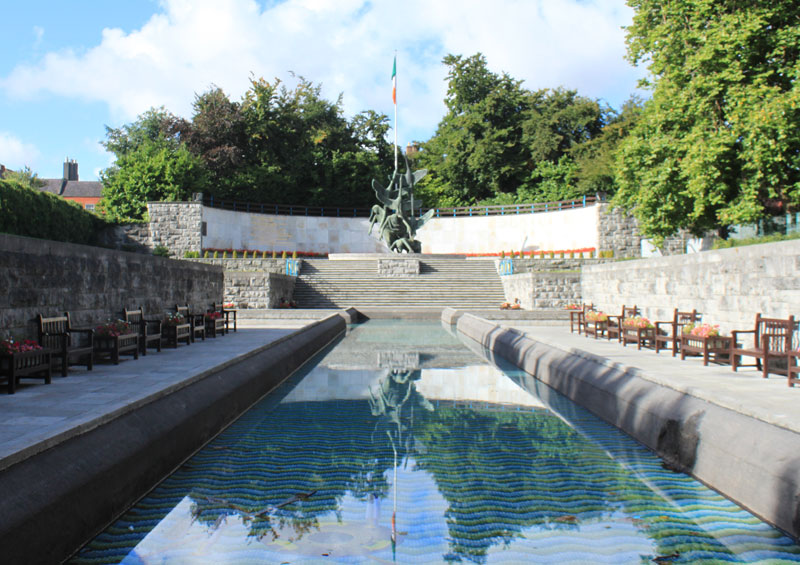 The Garden of Remembrance in Dublin was built in memory of all those who gave their lives fighting in the cause for Irish freedom. The memorial is built on the site where leaders of the 1916 Easter Uprising were held overnight before they were taken to the Kilmainham Gaol to be executed. The dominant feature in the garden is a sculpture representing the Children of Lir who had to live in exile for 900 years, similar to the 900 years of oppression the Irish suffered under British occupation.
The Garden of Remembrance in Dublin was built in memory of all those who gave their lives fighting in the cause for Irish freedom. The memorial is built on the site where leaders of the 1916 Easter Uprising were held overnight before they were taken to the Kilmainham Gaol to be executed. The dominant feature in the garden is a sculpture representing the Children of Lir who had to live in exile for 900 years, similar to the 900 years of oppression the Irish suffered under British occupation.
A reflecting pool has images of swords, spears, shields an implements of warfare painted on the bottom. In the Celtic tradition clans who did battle cast their weapons into the sea or a lake after the battle is over to symbolize the end of hostilities.
The Garden of Remembrance is a thin place.
Thin Places: Irish Gateways to the Otherworld
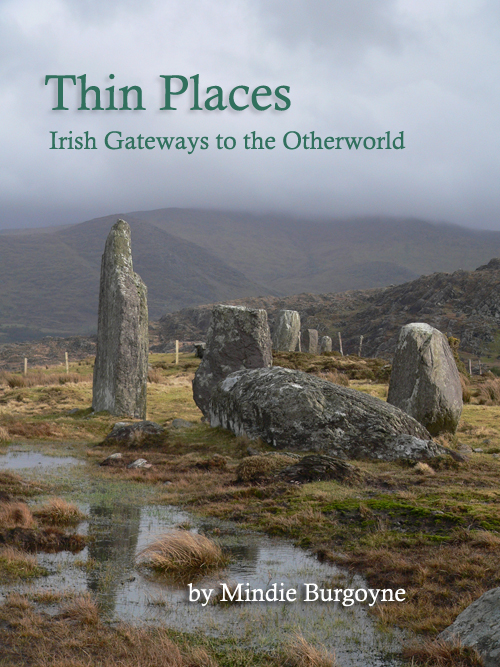 Thin Places: Irish Gateways to the Otherworld, by Mindie Burgoyne will published in 2015.
Thin Places: Irish Gateways to the Otherworld, by Mindie Burgoyne will published in 2015.
The book is approximately focuses on places where the veil between this world and the eternal world is thin. These could be places with a powerful spiritual energy – places that were marked sacred by people who lived centuries ago – places where people still go to feed the spirit and the mind.
The book includes commentary about 33 sites in Ireland – some familiar such as Glendalough, the Hill of Tara, Newgrange, Croagh Patrick, Glencolumkille, the Aran Islands and Carrowkeel, and some more obscure like Ardboe, St. Berrihert’s Kyle, Cashelkeelty Stone Circle, Ardmore and Doolough. Additionally, the book will highlight beliefs and practices regarding thin places such as earth energies, rituals and the connection between sites, geography and the Celtic year.
Mindie Burgoyne has been traveling to Ireland and researching thin places for 20 years. This book is an accumulation of the most mystical places she’s been. It allows the reader to go on a vicarious journey – walking in two worlds.
RESERVE YOUR COPY – NO PURCHASE UNTIL PRINTED
Those interested in obtaining a signed copy one of the first thousand books printed should email tours@travelhag.com with your request. Include your NAME and ADDRESS and email where you’d like to receive notification of publication date. You will be among the first to receive signed copies.
No personal contact information entered on the form will be shared. This is strictly for those interested in reserving one of the first copies of Thin Places.
Beltany Stone Circle – Thin Place in Co. Donegal
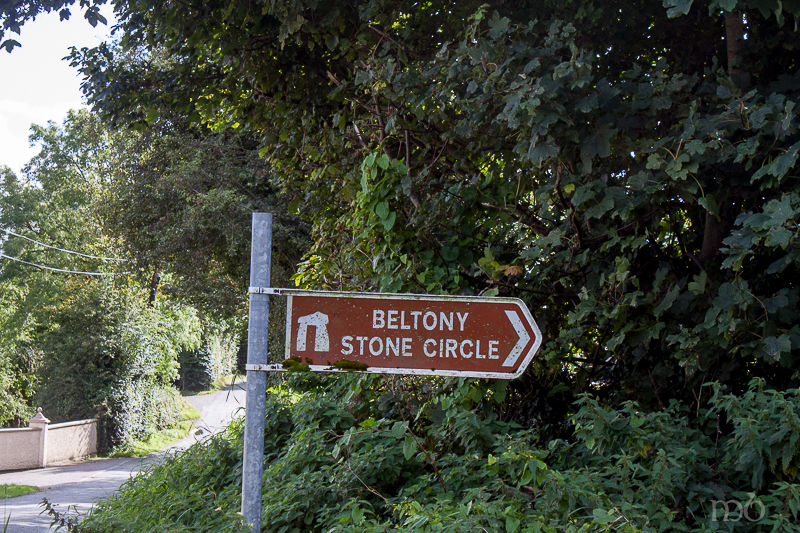 If a thin place is one where the veil between this world and the eternal world is “thin,” then Beltany Stone Circle in County Donegal ranks as one of the thinnest or most mystical sites in all of Ireland.
If a thin place is one where the veil between this world and the eternal world is “thin,” then Beltany Stone Circle in County Donegal ranks as one of the thinnest or most mystical sites in all of Ireland.
The circle dates back to 1400 – 800 BC, and is larger than most found in Ireland having 64 stones averaging 6 ft. in height. The circle measures about 145 feet in diameter. The site was excavated in the early twentieth century and significantly disrupted. Most believe that there were at least 80 stones in the original circle. These stones are orthostats – stones set against a rise or wall. They stand close together hemming in a raised earthen area resembling a kind of kerbing as seen in passage tombs. Some suspect that the circle and its center mounds could have comprised some kind of burial site that may have once been covered with earth. Others think the center “lumpiness” is a result of the disheveled condition the excavators left the site in back in the early 1900s.
The name Beltany is an Anglicization of the Irish word Bealtaine which is the feast of fire or rekindling the sun. Bealtaine festivals are celebrated on May 1st which is also the beginning of summer in the Celtic year. May 1st is the halfway point between the Spring equinox (the day when light and darkness are equal in hours) and the Summer Solstice (the longest day of daylight). The rituals on this day were linked to fire, particularly on hill tops across the landscape. Some believe this was a kind of refueling or re-firing the sun, or a form of worship that called down a blessing on the land and crops from the god of the sun.
The Beltany stone circle is located on Tops Hill. A wooded path (often muddy) leads from a car park to the summit. At the end of the shaded path, the landscape opens wide and in the distance, in a lone field one can see the jagged points of stones in a large stone circle. The transition from path to field feels much like a portal. There is a defined energy in this fields that grows stronger as one approaches the circle.
But there are two interesting stones in the circle that suggest it was used for measuring the seasons using astrological alignments, and possibly used for rituals related to the sun or sun god. These would be the tallest stone in the circle and the widest – the triangular stone with cup markings.
Most of the stones are tall and cylindrical in shape listing to one side or the other of the circle line. They resemble jagged old teeth. But the wide triangular stone, stands out. It’s special and immediately draws the eye. Additionally, it has cup markings on the inner face carved into it long ago. It faces ENE and stands directly across the circle from the tallest stone (about six feet high) which points WSW. When the two stones align they point to the summit of a hill about five miles away in Tullyrap – a summit where the sun rises directly over on May 1st – the feast of Bealtaine.
There are also noticeable outliers which may also have had a significance. According to Cary Meehan in her book A Travelers Guide to Sacred Ireland, “a line from the tallest stone in the south western part of the circle taken through the outlier, goes 28 miles south east to Bessy Bell Hill in Tyrone. Another line could run through the circle to Croaghan Hill, 4 miles ESE. ”
So Beltany Stone Circle could have been a passage tomb(s) or a tool for charting the agricultural seasons. It may have been aligned with other sacred sites. We know it was used for celebrations specifically linked to Bealtaine. Three carved stone heads dating to the Iron Age were found at Beltany during the excavation. They indicate that the circle was used for many centuries.
Today, though it’s been disrupted and disheveled, it still sits in place – marking the spot so many believed to be sacred. There site is still charged with energy. Even in the pouring rain, it offers a sense of thinness, of being in two worlds at one time.
Beltany Stone Circle is on the Images in the Landscape Tour in 2018.
Ardboe – Mystical Site on Enchanted Lough Neagh
ARDBOE or Ard Bó – a thin place in County Tyrone.
In Irish the name means Height of the Cow. The Ardboe high cross stands 18 feet high on the shores of Lough Neagh. It has 20 scenes from the Old Testament carved into its shaft that are still quite clear even after centuries of weathering out in the elements.
This and similar high crosses throughout Ireland were teaching tools used by the monks for religious education. In the early days of the Church, few villagers or farmers could read, so the bible scenes on the cross were used as a way to illustrate the lessons of the new Christian religion.
St. Colman founded a monastery in the 7th century on this site and built a church. The name Ardboe came from a legend that the mortar used to build that church came from a magic cow that emerged from the lough (Lough Neagh) that had gone dry. The milk from that cow gave strength to the builders as well as the building. In the 16th century, that old church built by St. Colman gave way to a new church – a church that still stands today as a crumbling ruin on the shores of Lough Neagh, clinging to that holy space, drawing its energy.
Lough Neagh is linked to enchantment, believed to be a dwelling place for the fairies. One of tales of Lough Neagh’s origin is that Finn MacCool, the famous Irish giant from Ulster, was chasing his arch-rival from Scotland and the rival was getting ahead of him. Finn MacCool reached down and scooped up a handful of dirt and stone and flung it at the fleeing Scottish giant, missing him by miles. The dirt and stone fell into the Irish Sea and became the Isle of Mann. The hole left in the ground from where Finn scooped up the dirt, became Lough Neagh. The Lough is now the largest freshwater lake in Ireland and Britain, covering 151 square miles and touching five of the six counties of Northern Ireland. For centuries people have believed that its waters have healing powers.
The energy around Ardboe is palpable. It is likely that the land where the monks of St. Colman built the church was already identified as a sacred site. When approaching Ardboe cross and church, one is called to be still. The entire landscape of water, grass, trees and stone is knitted together with a kind of oneness that clings to its past — even while sitting in the present.
To approach Ardboe is to walk into that time of St. Colman and the time of the people before him who also worshiped and prayed at this sacred, thin place. I’m not the only who has felt that special energy of Ardboe. My friend, Maura Brooks, a native of County Tyrone so believes in the mystical energy of Ardboe that she brings travelers to the site on a regular basis. It is Maura who introduced me to Ardboe, and she’s produced a short video about it that give some great commentary from a local perspective.
Irish writer, Polly Devlin, who grew up near Ardboe wrote about the Arboe church site in the 1950s…
The position of the small primitive group of holy buildings silhouetted against water and sky affects us, and most visitors, to initial stillness and silence. The crumbling arched windows frame the perpetual movement of the small crested waves of the lough.
Ardboe is a thin place. It is a stop on our Thin Places tour of Northern Ireland in Sept. 2018.
In the Irish Game of Thrones – Brian Boru Won
The story of Brian Boru, High King of Ireland, plays out like the popular HBO television series Game of Thrones. In the late tenth century, Ireland had about 500,000 inhabitants and 150 kings. It was an old land – a land of tribes and chieftains constantly battling for power and control. No man, woman or child was spared the gruesome, bloody scenes that come with constant war.
Brian Boru was one of eleven sons born to a chieftain who ruled over Thomond, a region covering most of north Munster. He died when Brian was just ten years old. They lived in County Clare in an area now known as Killaloe, a small village on the River Shannon. Being the son of chieftain, Brian was trained as a warrior and he saw more than his share of violence, torture, injury and death. When the local clans weren’t warring, the Vikings were invading. Though Brian grew up to become a great warrior and leader, he also developed superb political skills. These skills paired with his love for Ireland pushed him to become the most successful leader of his time.
At an early age, Brian was ruling Thomond. By the time he was 35 he had ascended to the royal seat of Munster, Ireland’s southwestern province. The High Kings of Munster ruled from the Rock of Cashel , but some historians believe that Brian chose to rule from Kincora, his estate in Killaloe. Brian fathered many sons with several wives, one of whom was a Viking. But as much he traveled throughout Ireland battling and politicking, his home base was always at Kincora. Today, the ramparts of his castle there are still visible in a wooded area off an unmarked path in Killaloe.
Brian Boru Becomes High King in 1002
As in the Game of Thrones where rulers of the seven kingdoms seek the Iron Throne, Brian Boru sought the position of High King. He achieved it when he was 61 years old. Ireland has had many High Kings, but Brian was the only High King who united the entire country for one common cause – to defeat the Norse invaders.
On Good Friday, April 23, 1014, Brian Boru and his sons led an army in a battle at Clontarf near Dublin. There was great loss of life including Brian’s son and grandson, but the 73 year old High King survived. His army defeated the Vikings, driving them into the sea back to their Nordic homelands.
While Brian had a few domestic enemies who ultimately joined the Vikings in battle against him, the Irish masses were behind the High King. And it was this unified spirit that enabled Brian Boru to lead the effort that expelled the Vikings for good. His political savvy, warrior strength and unrelenting determination brought Ireland to a place where the people were united, liberated and poised to grow as a nation.
Brian Boru was undoubtedly the most successful king in Ireland’s history.
Brian Boru and Sons are Buried at Armagh Cathedral
When the Battle of Clontarf was over and the Norse were driven out into the sea, Brian Boru’s army collected its dead and tended to its wounded while the High King returned to his tent alone, to rest. At some time during the night several fleeing Norseman came upon Brian’s tent and found him alone and vulnerable. They assassinated him.
Brian Boru’s warriors carried his body from Clontarf all the way to Armagh, the Christian capital of Ireland. The High King was buried on the grounds of St. Patrick’s church with the bodies of his son and grandson who had died in the battle. Today St. Patrick’s Cathedral stands where the old church stood. On its outside wall, a marble engraved sign reminds Cathedral visitors that Brian Boru was was laid to rest on the north side of the great church.
Today – April 23rd marks the 999th anniversary of the Battle of Clontarf and Brian Boru’s death.
902 Years and a Day Later
Sadly, after Brian died the country fell back into anarchy with warring tribes and clans vying for power. That unity under Brian Boru was never achieved again by the Irish people – not until 902 years and 1 day later when on Easter Monday, April 24, 1916 the Irish started a unified rebellion that eventually won 26 of Ireland’s 32 counties independence from Great Britain.
*
NOTE: The story of Brian Boru is beautifully told in The Lion of Ireland by Morgan Llywellyn. I highly recommend reading it before taking a trip to Ireland. It has so much history in it. When you visit knowing that history the landscape comes alive.
